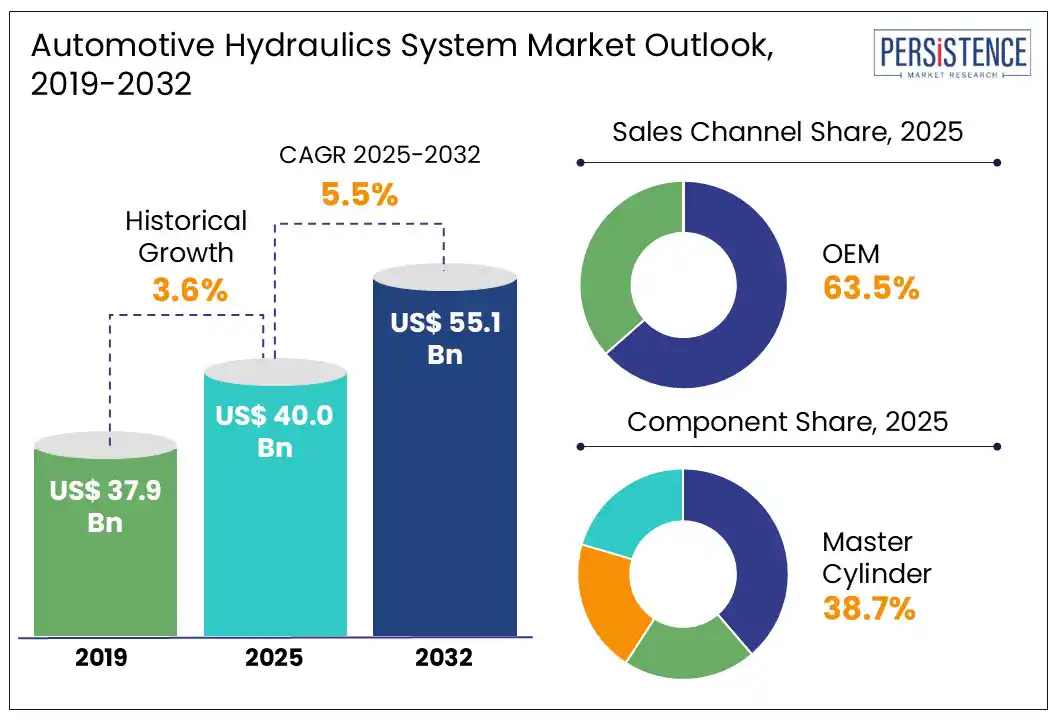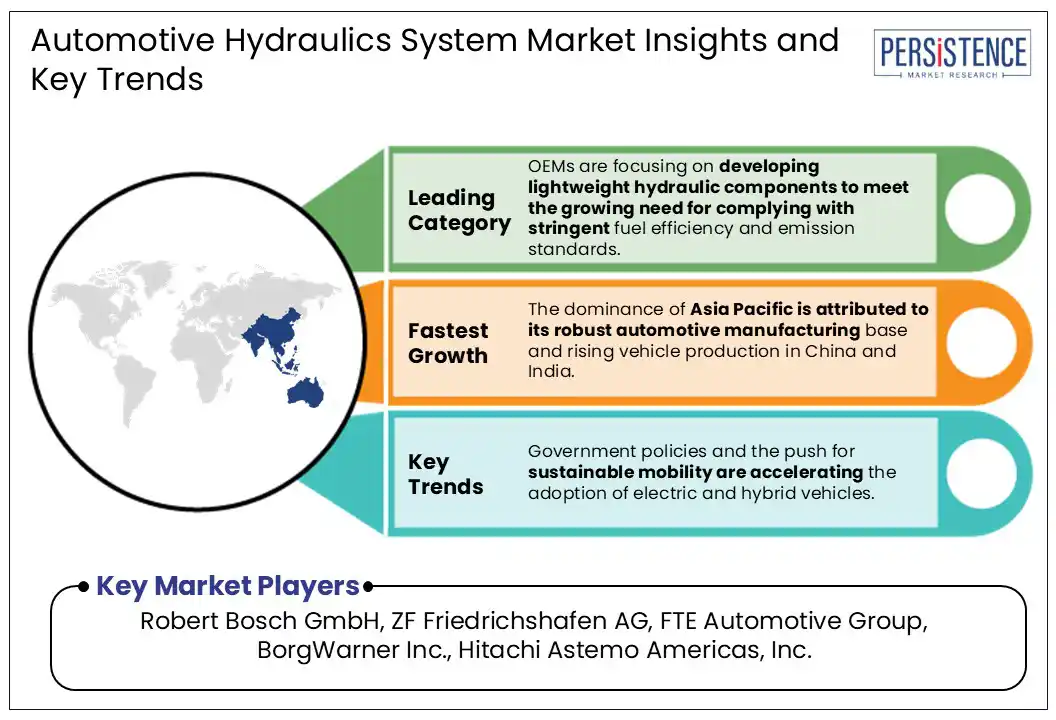ID: PMRREP34747| 193 Pages | 24 Jul 2025 | Format: PDF, Excel, PPT* | Automotive & Transportation

The global automotive hydraulics system market size is likely to be valued at US$ 40 Bn in 2025 and it is estimated to reach US$ 55.1 Bn by 2032, growing at a CAGR of 5.5% during the forecast period 2025-2032. The automotive hydraulic systems market is experiencing growth driven by rising vehicle production, growing demand for fuel-efficient systems, increasing adoption of advanced driver assistance systems (ADAS), and the expansion of commercial vehicle fleets. Automotive hydraulic systems play a critical role in vehicle performance, supporting core vehicular functions such as braking, power steering, suspension, and transmission.
Automotive hydraulics systems rely on fluid power to deliver high force and precise control, ensuring operational efficiency and safety across a wide range of automotive applications. For example, there is a significant demand for hydraulics in the construction, agriculture, and manufacturing, where heavy-duty vehicles are extensively used. Hydraulic systems are an integral component of both passenger and commercial vehicles, as the demand for advanced vehicle functionalities is growing rapidly growing.

Key Industry Highlights:
| Global Market Attribute | Key Insights |
| Automotive Hydraulics System Market Size (2025E) | US$ 40 Bn |
| Market Value Forecast (2032F) | US$ 55.1 Bn |
| Projected Growth (CAGR 2025 to 2032) | 5.5% |
| Historical Market Growth (CAGR 2019 to 2024) | 3.6% |
The automotive hydraulics system market growth is propelled by the rapidly rising demand for high-performance hydraulic solutions in heavy-duty applications across construction, agriculture, and industrial manufacturing, especially in emerging economies. These systems are essential for delivering power, precision, and reliability in vehicle operations, particularly in braking, steering, and suspension systems. As economic growth gains momentum in developing nations, the need for robust hydraulic components is likely to intensify, further boosting their adoption and aiding the market.
Technological advancements in hydraulic equipment are also shaping the future growth trajectory of this market. Innovations in the form of compact design, energy efficiency, and precision engineering are enhancing system performance and durability. This evolution is enabling manufacturers to meet the increasing expectations for reliability and operational efficiency, positioning hydraulic systems as the core of modern automotive engineering.
Despite the growing demand for hydraulic systems in vehicles, the market potential is not materializing fully owing to the challenges it faces. One major concern is the high maintenance cost associated with hydraulic components, particularly due to the wear and tear on cylinder tubes and the inevitability of material degradation. These issues increase the total cost of ownership and can deter adoption, especially in cost-sensitive markets.
Another critical factor affecting market growth is the contamination of hydraulic fluids, which can compromise system reliability and performance. Vehicles cannot operate optimally if the fluid running through the system is not clean. Any contamination can lead to reduced efficiency and increased downtime. These reliability concerns have heightened the urgency for improved fluid management and durable component design of automotive hydraulics systems.
The global transition toward electric vehicles (EVs) and hybrid vehicles is generating fresh growth avenues in the market. According to the International Energy Agency (IEA), global EV sales exceeded US$ 17 Mn in 2024. Hydraulic systems are being increasingly integrated into electric vehicle platforms to support functions such as regenerative braking, active suspension, and power steering. The application of hydraulics enhances vehicle efficiency and performance, making these systems a valuable component in next-generation clean mobility solutions.
The rise of autonomous vehicles is widening the scope of hydraulic technology in automotive design. The need for precise control and efficient energy transmission in autonomous systems makes hydraulic solutions ideal for critical vehicular functions. With a larger number of vehicle makers adopting high-end automation technologies, the market is expected to benefit from this trend.
By sales channel, the market has been bifurcated into original equipment manufacturers (OEMs) and aftermarket. OEMs are set to dominate the market, capturing approximately 63.5% revenue share in 2025. OEMs are intensely focusing on developing lightweight and compact hydraulic components to meet the growing need for complying with stringent fuel efficiency and emission standards. These innovations are enhancing vehicle performance, optimizing energy usage, and supporting regulatory compliance across global markets. OEMs are also integrating advanced technologies such as predictive maintenance and real-time diagnostics to boost system reliability and reduce operational costs. This strategic emphasis on performance and efficiency is positioning OEMs as key contributors to the evolution of the automotive hydraulic systems market.
Based on component, the market has been divided into master cylinder, slave cylinder, reservoir, and hose. The master cylinder segment is projected to capture a significant 38.7% revenue share in this market by 2025. The growth of this segment is driven by the utilization of advanced materials such as aluminum alloys and composites, which improve fuel efficiency while maintaining structural integrity in vehicular components. These lightweight solutions are increasingly favored by manufacturers aiming to meet performance and sustainability goals.
Furthermore, technological innovations in hydraulic systems, such as enhanced sealing techniques and precision manufacturing, are boosting the durability and efficiency of master cylinders. The integration of these systems with electronic sensors allows for real-time monitoring and adaptive control of brake fluid pressure, improving braking responsiveness and vehicle safety in a significant manner.
By on-highway, this market has been segmented into passenger cars, light commercial vehicles, and heavy commercial vehicles. In 2025, the passenger cars segment is estimated to hold around 57.5% of the market share, making it the largest revenue contributor. This dominance is due to the integration of advanced hydraulic systems aimed at enhancing safety, control, and performance of vehicles. Manufacturers are increasingly combining hydraulic technologies with electronic stability control (ESC) and anti-lock braking systems (ABS) to deliver superior braking efficiency and handling.
The push for fuel efficiency and lower emissions in passenger vehicles is also influencing the engineering of hydraulic components, with a rising number of carmakers actively shifting toward lightweight materials. Additionally, the integration of hydraulic systems with autonomous driving technologies is enhancing precision control and improving reliability in self-driving cars, accelerating the growth of the passenger cars segment.

Asia Pacific is anticipated to hold 33.16% of the market share, surpassing one-third of the total share. The dominance of this region is largely attributed to its robust automotive manufacturing base, especially in East Asia, and rising vehicle production, particularly in the key economies of China and India. These nations are serving as hotbeds for both passenger and commercial vehicle assembly, driving substantial demand for hydraulic systems. On a broader level, the market for automotive hydraulics systems in Asia Pacific is also bolstered by rapid urbanization, increasing disposable incomes, and a surge in vehicle ownership across the region. Several established vehicle companies are also expanding their presence in India, China, and Vietnam by setting up assembly plants and regional offices, which are enabling them to make heavy investments in advanced automotive technologies in the region.
The Europe automotive hydraulics system market is poised for promising growth, supported by the region’s emphasis on advanced vehicle technologies and stringent safety standards. Countries such as Germany, France, and Italy, home to some of the largest and oldest automotive manufacturers, are driving the demand for high-performance hydraulic systems in both luxury and commercial vehicles.
An important aspect of Europe is the commitment of the European Union (EU) to sustainability, which is also shaping market dynamics. Concerted efforts to reduce emissions across the bloc is pushing auto manufacturers to proactively engineer hydraulic systems using lightweight materials. Government initiatives promoting electric and hybrid vehicles further accelerate the integration of advanced hydraulic technologies, positioning Europe as a key contributor to the market growth.
The market in North America is expected to undergo substantial expansion, aided by the widespread adoption of advanced hydraulic systems in both passenger and commercial vehicles. Stringent safety and performance standards set by governments in the region are prompting manufacturers to integrate hydraulic systems that enhance braking, steering, and suspension capabilities. Automation and smart technologies that enable real-time diagnostics and predictive maintenance for improved reliability are brightening market prospects. Importantly, North America boasts a robust automotive aftermarket that will sustain the demand for hydraulic components in the foreseeable future.
The global automotive hydraulics system market is experiencing cutthroat competition on account of continuous innovation and the introduction of advanced technologies by automakers. Leading companies such as Bosch and Schaeffler Technologies are expanding their product portfolios to meet evolving vehicle safety and performance standards. These giants are also investing heavily in research and development to develop advanced automotive hydraulic systems to maintain a competitive edge.
The competitive landscape of this market is also being characterized by an increasing focus of vehicle companies in aftermarket services. This competitive environment is consistently producing new opportunities for industry players to innovate and scale in response to shifting automotive trends.
The automotive hydraulics system market is projected to reach US$ 40 Bn in 2025.
Soaring demand for heavy-duty automotive applications across manufacturing, construction, and agriculture is driving the market.
The automotive hydraulics system market is poised to witness a CAGR of 5.5% from 2025 to 2032.
The increasing adoption of electric and hybrid vehicles and a growing demand for autonomous cars are key market opportunities.
Robert Bosch GmbH, ZF Friedrichshafen AG, and FTE Automotive Group are some of the key players in the market.
| Report Attribute | Details |
| Historical Data/Actuals | 2019 - 2024 |
| Forecast Period | 2025 - 2032 |
| Market Analysis | Value: US$ Bn |
| Geographical Coverage |
|
| Segmental Coverage |
|
| Competitive Analysis |
|
| Report Highlights |
|
| Customization and Pricing | Available upon request |
By Sales Channel
By Component
By On-Highway Vehicles
By Off-Highway Vehicles
By Application
By Region
Delivery Timelines
For more information on this report and its delivery timelines please get in touch with our sales team.
About Author